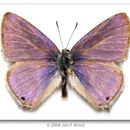en
names in breadcrumbs


Abundant
Often found flying very rapidly around stands of pea plants. In these circumstances it can be quite numerous
Most of the small number of native butterflies in Egypt belong to the Lycaenidae family (the Blues). The Long-tailed Blue is the commonest, their larvae feed on many kinds of leguminous plants.
Size: 30-36 mm. Very variable in size. The hindwing has two black spots near tail. The underside of the wings are pale brown with pale transverse wavy lines including a broad white band. The upperside of the wing of the male is violet-blue; while in the female is brown with variable violet-blue.
Widespread. AOO = 232 km2. EOO = 740,000 km2. More than 10 locations.
Widespread (Africa, southern Asia, Australia, Hawaii, and southern Europe)
Cultivated areas everywhere.
Least Concern
Several generations per year.
92 records. Latest in 2006 (several places)
Can be a pest of legume crops such as peas and beans since crop unmarketable
Resident and migrant
All the year
Host-plants: Leguminosae - including cultivated crops, Tephrosia, Astragalus, Crotalaria, Colutea, Medicago, etc.; in Sinai prefers Colutea istria.
Lampides boeticus, the pea blue,[2][3] or long-tailed blue,[3] is a small butterfly that belongs to the lycaenids or gossamer-winged family.[4]
The Latin species name boeticus refers to Baetica, a province of the Roman Empire in the Iberian Peninsula . Its common name refers to the long streamers on its hind wings, the male's bright iridescent blue colour, and peas, which is the typical host plant of the butterfly.
This species can be found in Europe, Africa, South[2] and Southeast Asia, and Australia.[3] Also found in the Hawaiian islands.
This species inhabits the edge of forests, mountain meadows and hot flowery places at an elevation up to 2,700 metres (8,900 ft) above sea level.[5][6][7]
The wingspan is 24–32 mm for males and 24–34 mm for females.[6] In these small butterflies (although unusually large for their family) the males have a mainly blue violet upper face of the wings with the brown edges, while the females have only a small amount of blue colour in the centre of the wings (sexual dimorphism).[8][9] Both sexes have a thin, long tail in the hindwings and two black spots in the anal angle. The underface of the wings is ocher and adorned with white markings and with a larger white submarginal streak.[7]
The underface of each hindwing shows a pair of small black eye-spots beside each tail, with an orange marginal spots at the anal angle.[8] This species is rather similar and it can be confused with Leptotes pirithous and Cacyreus marshalli although the pea-blue is significantly larger than both species.
Male. Upperside violet-blue, with hair-like, whitish scales dispersed over the entire surface of both wings. Forewing with costal and outermarginal brown line, the latter often with a little inward brown suffusion, Hindwing with a similar marginal line, a rather large round black subterminal spot in interspace 2, a smaller spot in interspace 1, each spot ringed, sometimes with pale blue, sometimes with pale orange-ochreous. Cilia white, with a brown basal band; tail black, tipped with white. Underside grey with a slight ochreous tinge, markings brownish. Forewing with a pair of bars across the middle of the cell, and a pair across the end, a pair in the disc, from near the costa to vein 3, continued a little inwards to the hinder margin in two pieces, all with white inside the pairs. Hindwing with eight or nine more or less sinuous brown fasciae at even distances apart, all the brown lines with white marks between them; both wings with brown terminal line, white subterminal line, then a series of white lunules, followed by white marks, more or less in echelon on the forewing, formed into a white narrow band on the hindwing, the whole surface of both wings having these markings at even distances apart; and there are small jet black subterminal spots, containing metallic, blue-green scales, broadly surrounded by orange, in interspaces 1 and 2. Female. Upperside with some slight brownish suffusion, some shining blue scales at the base of both wings and in the interior portion of the forewing; on the hindwing there are two spots in interspaces 1 and 2 as in the male, and some pale brown spots in continuation up the wing, all outwardly edged by a fine white subterminal line, and across the disc there is a narrow white band, divided by the veins. Underside as in the male. Antennae black, ringed with white ; head and body blackish-brown above with blue pubescence, white beneath.
This species may have three generations a year. Adults fly from February to early November and are strong migrants.[6][7] Eggs are white with a greenish tinge and have a disc-shaped form. They can reach a diameter of 0.5 mm. They are laid singly on the flower buds of the host plants.[8]
Old caterpillars are green or reddish-brown, with dark dorsal stripe. They reach a length of 14-15 mm. Pupae reach a length of 9-10 mm. They are light grayish-brown with medium-sized dark spots and dark dorsal stripe.[5]
The larvae feed on flowers, seeds and pods of many Fabaceae species, including Medicago, Crotalaria, Polygala, Sutherlandia, Dolichos, Cytisus, Spartium and Lathyrus species.[3][10] It has also been recorded on Crotolaria pallida.[11]
In Australia, the larvae are occasionally attended by ants in the genera Froggattella, Iridomyrmex or Camponotus.[12]
Lampides boeticus, the pea blue, or long-tailed blue, is a small butterfly that belongs to the lycaenids or gossamer-winged family.